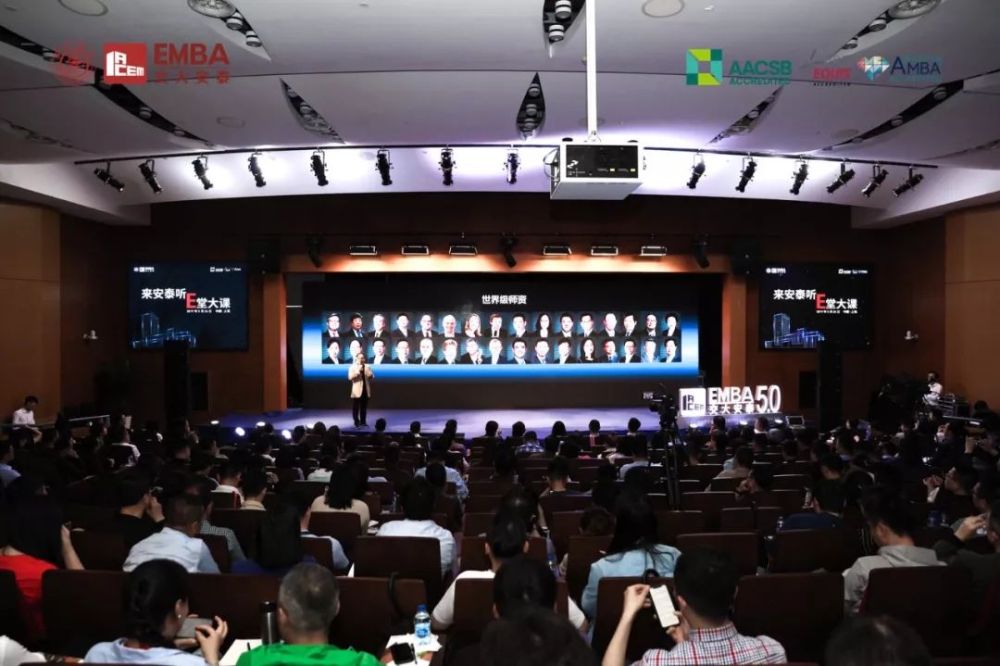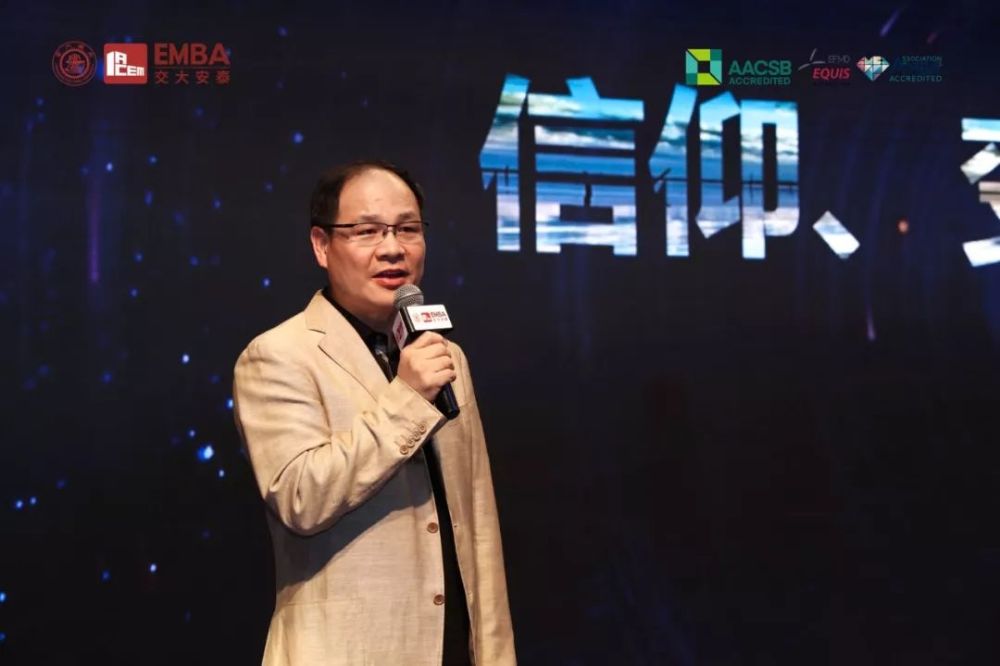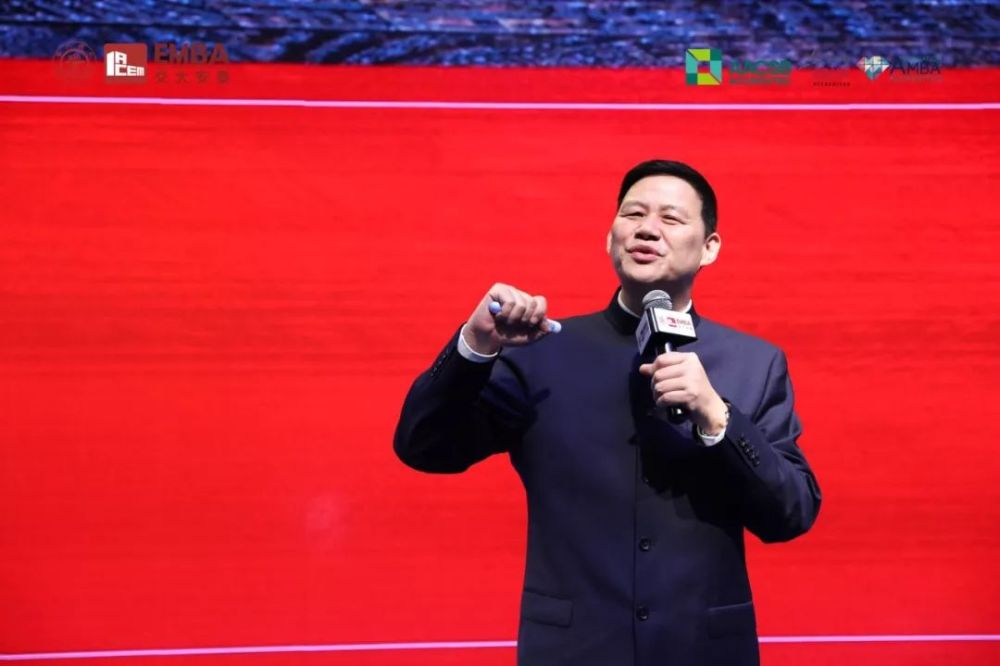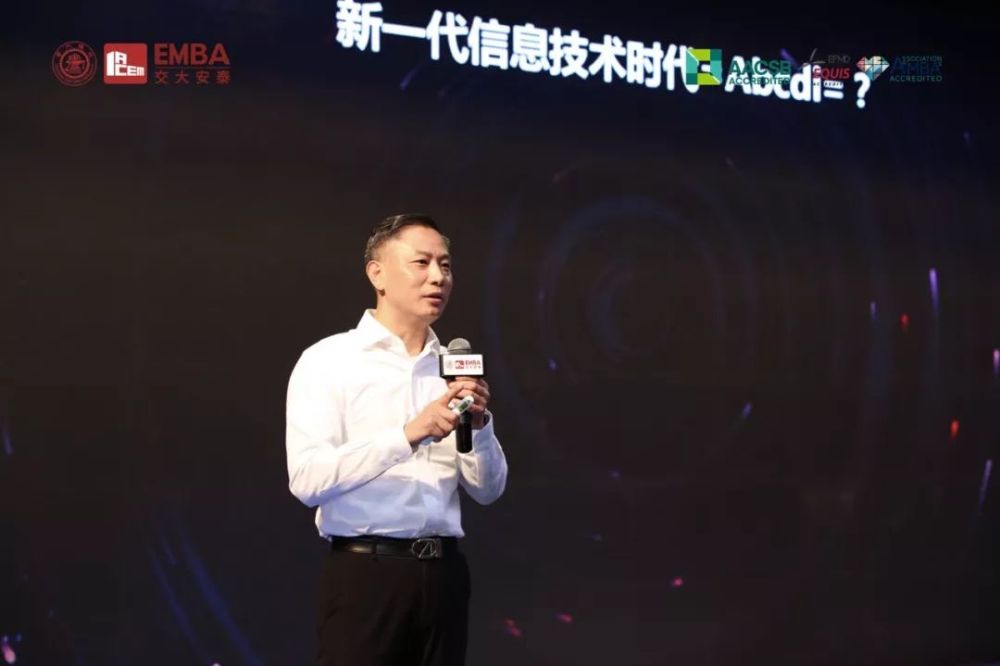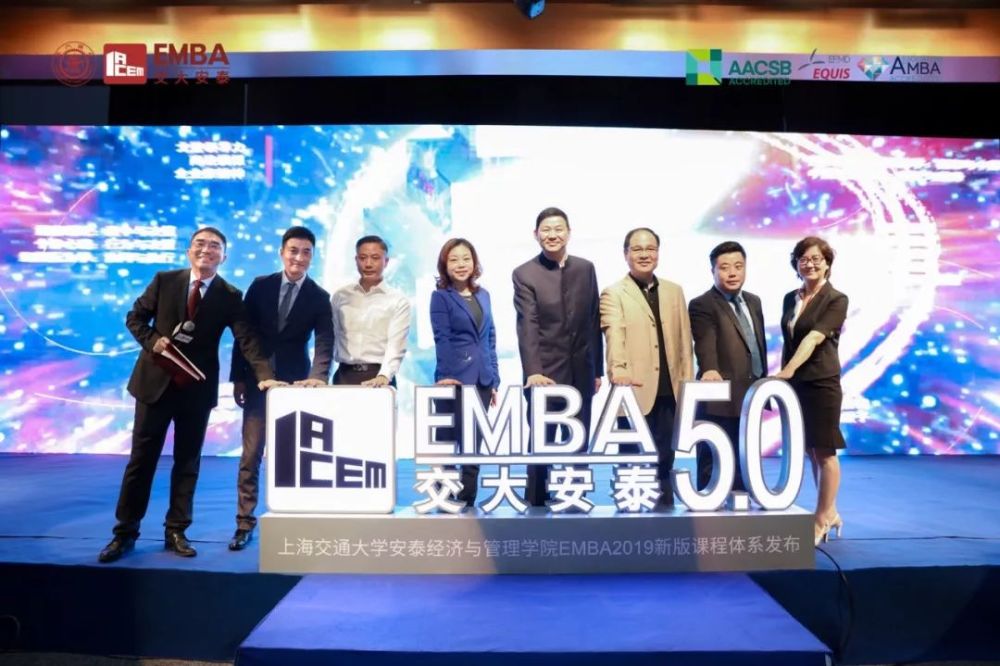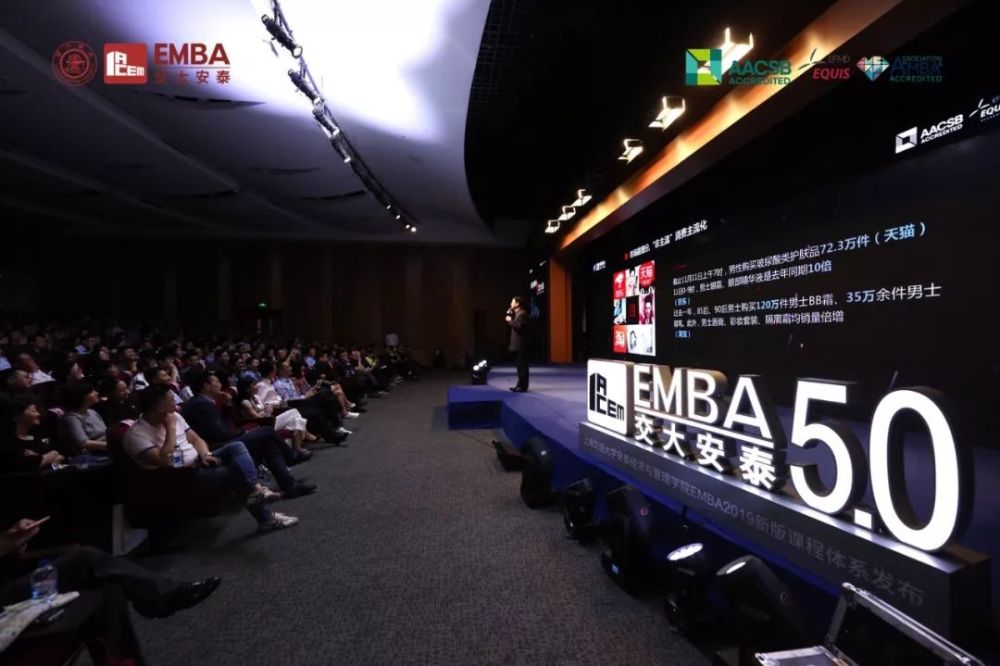New 5.0 Curriculum System of Antai EMBA of SJTU Released
Time:2019.05.26 Publisher:EMBA OfficeOn May 26, 2019, the new 2019 curriculum system of EMBA of Antai College of Economics and Management, Shanghai Jiao Tong University (hereinafter referred to as Antai) was officially released. Since it was established in 2002, the Antai EMBA project has insisted on curriculum innovation every four years, which has been upgraded from version 1.0 to version 5.0. What is the pertinence of the latest curriculum system? Let’s go into the class toghter.
Yu Mingyang, Professor of Antai marketing, Dean of China Development Research Institute, Professor of EMBA; Chen Yamin, Professor of Antai accounting, director of Accounting Research Institute, Expert of Accounting Standards of Ministry of Finance, Professor of EMBA. Ren Jianbiao, Assistant Dean of Antai, Director of EMBA Project, Professor of EMBA. Huang Haiqing, Grade 2007 alumni of Antai EMBA, President of Shanghai CITIC Information Development Co., Ltd; Ma Wenyu, Director of EMBA Center, Zhou Daoli and Yuan Zhongxia, Assistant Director, all of the above attended this event.
Ren Jianbiao: EMBA5.0 IS Take the Global Trend and Facing the Future-
Inheriting of the 123-year history of SJTU, Antai is a business school under the background of a century-old comparative and research-oriented famous university with science and engineering as its main characteristics. Because of this, based on the unique and complete discipline layout and the guidance for future development, Ren Jianbiao declared that it is necessary to build an innovative curriculum system with academic research and knowledge creation as the core of the comprehensive SJTU, and to build a first-class EMBA project with both academic and market influence.
The Antai EMBA project was established in 2002, the concept of "thinking about change" runs through it all the time. "We should not only actively respond to changes, but also actively seek changes" is Ren Jianbiao’s attitude towards the development of Antai’s education. And Antai EMBA project has indeed achieved continuous integration and innovation across borders.
The Antai EMBA project insists on curriculum innovation every four years, which has been upgraded from version 1.0 to version 5.0. What are the highlights of the new 5.0 version?
The 5.0 version curriculum system consists of eight modules: school opening, macroeconomics, business decision, management practice, characteristics of SJTU, contention of a hundred schools of thought, international and graduation.
Firstly, students’ leadership is identified through the opening modules of Gobi Leadership, Business War Simulation and Entrepreneurship. Then, students' leadership will be generated, expanded and consolidated through a series of courses with 6 modules: school opening, macroeconomics, business decision, management practice, characteristics of SJTU, contention of a hundred schools of thought, international. Finally, through the "Leadership Reflection" course of the residential module of graduation, the students' leadership is reflected and applied.
What is the pertinence of the specific curriculum module?
School opening module
The school opening module is divided into entrepreneurship (2 days), business simulation (3 days), and Gobi leadership (3 days). Ren Jianbiao said that entrepreneurship and leadership are the most important spirit and ability for managers to cope with future uncertainties and changes; Antai EMBA is not only to train managers, but also to train leaders who can explore the future of business and guide the future development trend of business.
Therefore, in the school opening module, the trainees will study entrepreneurship for two days and they will also compete through team grouping to experience a three-day simulation of business war. What’s more exciting is that each 300 trainees will go to Dunhuang and Guazhou of Gansu Province, where Master Xuanzang once traveled for three days to shape team leadership.
Macroeconomics module
Macroeconomics module includes two main courses: Macroeconomics: Framework and China Theme, and China Economic Practice: Theory and Trends.
Ren Jianbiao said that we are rooted in the soil of China, but also integrated into the world. Understanding the global economic environment and in-depth study of the essence of China's economy can enable us to combine internal and external business exploration and seize the development opportunities of the times.
Business decision module
For business decision module, it is based on 3 aspects include Game Theory: Ompetition and Decision, Individual Psychology: Behavior and Decision, Organizational Behavior: Coordination and Execution.
The game thinking of enterprises should not only be applied to industrial competition, but also be established in the process of enterprise self-construction. In addition, business decision should not only study the behavior and decision of each organization, but also witness the behavior and decision of each individual.
Management practice module
Management practice module consists of nine classic courses of SJTU, including financial management, operation management, marketing, corporate finance, human resources management, information technology management, international business, strategic management, corporate governance.
Professors of SJTU will fully combine their consulting experience and academic research summary in enterprises, and each course will be shared and discussed with the students for four days.
Characteristics of SJTU module
The characteristics of SJTU module focus on 3 integration (Company Profit Model Competition, performance improvement, leadership reflection), 6+ (opening innovation+, Finance+, Internet+, intelligence+, humanities+, industry+) and 1 inquiry (SJTU inquiry).
Among them, "industry+" is based on the newly established Industry Research Institute of SJTU in 2019. In the future, Antai EMBA project will take the research report and research results of Industry Research Institute as the learning content of each main course, discuss and share with the students in time, strive to crisscross, integrate knowledge and practice, so that theoretical learning and Practice will no longer derail.
Contention of a hundred schools of thought module
The contention of a hundred schools of thought module plans to enrich the subject's management and business economy courses in half a day or one day. Among them, there are many studies, such as Silicon Valley entrepreneurship history, science and technology development history, new media marketing, Anti-Unfair Competition Law, business theory and sustainable development, Chinese learning and leadership.
International module
The International module will organize students to attend overseas classes (the United States, Europe, emerging economies, etc.). Through in-depth practical study in first-class foreign business schools and famous companies, students are encouraged to broaden their horizons, experience differences, change their thinking, reform and innovate. It is noteworthy that EMBA students can still choose international courses after graduation.
Yu Mingyang: Nine New Business Opportunities in the Context of New Consumption
Yu Mingyang quoted Hegel as saying: Familiarity is not true knowledge. He believes that the learning in EMBA is actually the process of leading students from familiarity to truth. When they really understand the market, business opportunities can also be easily found.
So, what new business opportunities will there be in the future? Based on the change of consumption trend, Professor Yu Mingyang offered us nine directions.
Business Opportunities 1: The post-90s become the main force of consumption and the purchase of products tends to be household
Data shows that in the period of Double Eleven in 2009, the consumption of Post-80s accounted for more than 60% of all consumption, but in the period of Double Eleven in 2018, the consumption of Post-90s reached 50% of all consumption. The Post-90s are gradually becoming the main consumption force. In addition, Yu Mingyang pointed out that Post-90s consumption has four characteristics: good-looking, no waiting, micro-participation and cleanliness.
According to the composition of product consumption changes, in 2018, the three major items are flat TV, air conditioner and washing machine, while the three minor items are floor sweeping robot, air purifier and vacuum cleaner.
Since the Post-90s have a higher understanding, acceptance and application ability of electronic and technological products than their parents, they also have absolute advantages and voice in the choice of black technologies.
Based on the changing trend of consumer groups and consumer products, business opportunities can be considered from these three perspectives in the future:
1) Intellectualization: VR, AI, Internet of Things, and organization of phones.
2) Hedonization: lazy, cleanliness, and experience optimization.
3) Domination: identify who is the "opinion leader" in purchasing.
Business Opportunity 2: Market super segmentation and mainstreaming of non-mainstream consumption
Yu Mingyang said that what used to be considered non-mainstream consumption has become mainstream consumption today. For example, the market of men's skin care products has increased dramatically in recent years, and its capacity has increased 30 times in the past decade.
Today, men's attention to blackheads has increased by 46%, and men's attention to whitening has increased by 44%. Besides, they also pay attention to mask, lotion, toner, sunscreen, eye cream and essence.
Yu Mingyang enlightened us that the boundary between "non-mainstream" and "mainstream" is weakening, and the niche product market is not small. In the mainstream market of the Red Sea, non-mainstream market, and fragmented time consumption are a big blue ocean market. If we achieve precise positioning and the best single product, it will be the "magic weapon" to win the market.
Business Opportunity 3: Attention to health, the era of national health care
Nowadays, people are paying more and more attention to their health. In 2018, the sales of medical beauty, oral cavity, hair transplantation and gene testing are more than three times as much as in 2017. The sales of an online reservation service for vaccines on Double Eleven are 9.7 times as much as in the same period of 2017.
The spring of the Enlarged Health is approaching, and the future market is huge. Product segmentation, measurable quality and service optimization have become three major points. And it is worth thinking about how to adapt the way of communication and promotion to the new generation of consumers.
Business Opportunity 4: Spiritual deposit, pet economy is in the ascendant
According to statistics, a dog now spends about 230 yuan just on snacks per month on average. At present, there are 27.4 million pet dogs in China. The average pet-keeping rate in cities is 11%. The sales of pet products via Suning are up 1731% in Double Eleven. In the next five years, the pet industry will witness a 20% high growth. "Dogs and cats" instead of "parents" may become a symbol of urban happiness.
Due to the virtualization of the Internet, urban people are lonely, empty and lack of spiritual sustenance. The fierce competition and high pressure of life, modern people have shallow depression, youth dementia, social terror. In addition, intelligence and convenience have greatly increased the leisure time of people. More importantly, the improvement of purchasing power, resulting in a huge consumer market.
Therefore, the future directions of spiritual life business are reflected in three categories:
1) The spiritual and group industries are still in their infancy and have a lot of space for development.
2) Education enterprise should pay more attention to the ideas, spirit and personality shaping, while frustration education should be paid more attention to.
3) The pet industry needs to upgrade to higher industries.
Business Opportunity 5: Market flattening, large market for 3rd- and 4th-tier cities
Because of the popularity of the Internet, the information of urban and rural consumers is completely shared, without any difference. Why there are more business opportunities in the 3rd- and 4th-tier cities? Yu Mingyang pointed out three reasons:
1) Rigid demands like housing, marriage and shopping occupy consumption market in 1st- and 2nd-tier cities.
2) It is difficult to stay in 1st- and 2nd-tier cities and because of aging of population, a large number of college graduates are flowing to 3rd-and 4th-tier cities.
3) Industries in 1st-and 2nd-tier cities are hollowing, while the golden-collar, blue-collar and white-collar classes are sinking.
On the other hand, observing the consumption phenomenon of the 3rd- and 4th-tier cities, people only see "secure jobs " and "part-time jobs". Trials and errors in many areas have been made in the 1st- and 2nd-tier cities. If the business model is shifted to the 3rd- and 4th-tier cities on the basis of revision, it will be a good business opportunity.
Therefore, Yu Mingyang said that we should pay great attention to the consumption characteristics and product characteristics of the 3rd- and 4th-tier cities, effectively lay out the areas of linkage and difference between the 3rd- and 4th-tier cities and 1st-and 2nd-tier cities, focusing on product gradient, terminal sinking, service follow-up and dissemination theme.
Business Opportunity 6: New pension industry
After 40 years of reform and opening up, some people got rich first, and Post-50s and Post-60s began to retire. In Yu Mingyang's view, this represents the retirement of the first generation of China's rich, and this group will also trigger huge purchasing power, advanced consumption concept and diversified demand.
Through market research, consultation and academic discussion, Yu Mingyang provided four major directions for entrepreneurs:
1) At present, the mode of "foods, accommodation and medical treatment" is far from adapting to the market demand.
2) Customized tourism, migratory lifestyle, and new global citizens.
3) Circle group living, with emotions and interests as the link between the circle group.
4) Participatory culture, from square dance to geriatric university, English corner, financial management salon.
Business Opportunity 7: New childhood market, childcare industry under the Two-Child Policy
Yu Mingyang said that high quality educational resources are always scarce resources, and the multi-basic education pattern caused by the scarcity of famous school resources will give birth to a huge off-campus market. In addition, whether physical, mental or cultural, China's childcare system is facing an upgrade in consumption, like prenatal education, maternity center, children's elements and experience center in urban combination, and the plight of new fathers and mothers, Post-90s, also brings new business opportunities.
Business Opportunity 8: The first year of AI, initiate the intelligent revolution
Nowadays, AI appears more in to business, which is reflected in the process of factory and manufacturing. In the next few years. AI will develop to the customer and home service robot will be in a blowout manner.
The World Robot Conference(WRC) puts forward the topic of the connection of human, material and intelligent. The intelligent revolution will change all industries and enterprises. The application of AI will be the development direction of manufacturing and service industries in the next 10 years.
Intelligence seamlessly connects people and objects, and human ability will be further stimulated. Intelligence will eliminate all repetitive, low-end labor. Manpower is liberated and destroyed. Intelligence will make people more confident but more lonely, and spiritual needs become luxury goods.
Business Opportunity 9: Clear behavior in the age of Big Data
Compared with the social science's conventional thinking when solving problems, Big Data attaches importance to quantification, and makes everything clear, so that everyone will have no privacy. Therefore, the future business layout of Big Data should focus on three perspectives: overall customization, consumption experience and accurate communication.
Huang Haiqing: The Future Has Come, from Interne+ to Intelligence+
Huang Haiqing, a veteran who has struggled in IT (Information Technology) industry for more than 20 years, is also an EMBA 2017 alumnus. He has witnessed the transformation of IT from PC era to Internet era, and is also experiencing the current Big Data era.
The future will be the era of the coexistence of mobile Internet and Internet of Things, that is, the era of ABCDI, A: Artificial Intelligence; B: Block Chain; C: Cloud Computing; D: Big Data; I: Internet of Things.
AI is the brain, providing algorithms; Cloud computing is the heart, providing computing power; Big Data provides data; Internet of Things is equivalent to the human nervous system, acquiring data, the four will form a four-dimensional integrated relationship.
The future will also be the era of seamless integration of the mobile Internet and Internet of Things, from the emphasis on business mode innovation to the era of independent technological innovation and business mode. Specifically, the connection between people and services, that is, communication links to the Internet and all walks of life, information and services create a new ecosystem in new fields; the connection between people, that is, communication and social interaction as the core, connecting the communication between people; the connection between people and devices/devices, using the Internet as the medium to enrich the possibility of future life, the above will form an effective closed-loop.
In 2018, the state proposed Digital China, and the digital economy has a close relationship with cloud computing. Now the proportion of digital economy in China is close to 20%. In the future, all walks of life in China will be digital. Electricity consumption in industrial age is an economic measurement index, and cloud in digital economy era will represent the development degree of digital economy.
In 2019, the state proposed intelligence+, we are now in the stage from Internet+ to intelligence+. Internet+ more focuses on innovation in profit mode, while intelligence+ is the integration of technology innovation and crossover.
In the new era, how can we conform to and lead the trend? From the perspective of Huang Haiqing, from the "Internet+" to the Internet of Things, Block Chain and AI, the syncretic application of new industry and technology may be our only opportunity.
The IT era consists of two parts: the PC era and the mobile Internet era. But in the IT era, the United States occupied an absolute dominant position. Huang Haiqing believes that China has no chance to overtake the United States by corner overtaking, and that the only way to overtake in the future is to change lanes.
The advent of a new era of information technology has given us the opportunity to change lanes and overtake. The advent of cloud computing era has subverted the old era of IT represented by the traditional PC King and IOE (IBM, ORACLE EMC).
Big Data must be supported by cloud computing
What’s the scale of Big Data? Every day, the Internet generates 2EB (Aibytes) of data, equivalent to the sum of 30,000 libraries in US Library of Congress and all the data owned by two Tencent cloud centers. In the future, everyone shall use data, and data will become a more valuable resource than oil. The rapid development of Big Data must be supported by cloud computing. Which means that without the era of cloud computing, there will be no era of Big Data. In the future, cloud brains will silently provide the safest, most massive, most transparent, most resilient computing and storage resources to escort Big Data.
Cloud computing is divided into IaaS (Infrastructure as Service such as CPU, hard disk, network port or wireless in PC-side), PaaS(Platform as Service such as Windows, Database, Big Data Platform), and SaaS (Software as Service such as QQ, Wechat, Search Engine, Government App). The whole cloud computing pattern is very strong in the United States, led by Amazon, Google and Microsoft perform strongly. Aliyun and Tencent currently account for only 1/10 and 1/20 of Amazon, respectively.
Currently, Ali and Tencent can compete with the United States in the IaaS, but China is still weak in the PaaS and SaaS. AWS, Microsoft, IBM are the top three in PaaS. And SaaS gave birth to SALESFORCE with the market value of $100 billion.
Six application areas of AI
What is AI? It is a technological science that studies and develops theories, methods, technologies and applications that can simulate, extend and extend human intelligence. Mobile Internet is still the interface between people and people, people and services. The Internet of Things becomes the bridge between things and things. In the future, AI or VR will become the most important application to connect the future.
AI is moving from special intelligence (features) to general intelligence development (Brain Neuroscience). At present, Chinese AI focuses on fields of listening (speech recognition, machine translation), speaking (speech synthesis, man-machine dialogue), watching (image recognition, txt recognition), learning (machine learning, knowledge learning), action (robot, automatic vehicle), and thinking (human-machine interaction, theorem proving).
AI mainly needs three things, the first one is computing power, the second one is algorithm, and the third one is data.
AI industry chain is divided into three levels: hardware computing power (basic level), perception and cognition (technical level), scene and product (application level). The United States occupies the core of the basic level, while China has abundant scenarios in application level.
China attaches great importance to the development of AI. The National Team of AI has initially formed national open innovation platforms for new generation of AI relying on Baidu company to develop automatic driving, relying on Aliyun company to build urban brain, relying on Tencent company to develop medical imaging, relying on IFLYTEK CO.,LTD. to develop intelligent language.
In the future, the greeters, sellers, cashiers, intelligent customer services, CALL CENTER, household hourly employees, nannies, taxi drivers, bus drivers, translators, court clerks, workers and radiologists will probably be replaced by AI.
Chen Yamin: The STAR Market and the Capital Market Reform
In terms of the STAR Market and the capital market reform, Chen Yamin believes that we should analyze from three perspectives of government, enterprises and investors. Chen Yamin started from the perspective of government, while enterprises and investors will carry out further detailed teaching for EMBA students.
At present, there are a series of major drawbacks in China's capital market, among which the obvious problem is that some of the capital market rules formulated by the state were mostly for the purpose of reforming state-owned enterprises, but now the whole system are outdated. In Chen Yamin's opinion, there are three aspects should be changed: the listing standards, the regulatory system and the issuance system.
Listing standards
From the standpoint of listing standards, China has long regarded profit measurement as the main criterion for listing, and the requirements for profit are getting higher and higher. But Chen Yamin thinks that profit usually represents mature enterprises, while many Internet start-ups and even mature enterprises have high cost in the development process.
Chen Yamin said that the GEM only accepts more than 30 million, that is a display board for successful entrepreneurial enterprises. In other words, money is king. Capital market should cooperate with the development of the whole national economy, high-tech enterprises and Internet IT. This is a matching combination.
Compared with the CBRC and the CIRC, the scale of China's capital market accounts for a small proportion of China's economy, but its role is far greater than that of the CBRC and the CIRC, because it also undertakes the allocation function of social wealth resources. Therefore, it also causes regulatory problems.
Regulatory system
As the saying goes, If the water is too clean, no fish can live in it. This shows that regulation is necessary, but it should be loose and moderate, not too strict.
The biggest problem in China's regulatory system lies in the regulatory thinking.
After making a further comparison between Chinese and American regulatory thinking, we can find that listing standards of the United States are clear and clearly implemented according to rules. Therefore, it is easier to get listed in United States, just meet the conditions. As for the problems in the United States is that investors play a decisive role in enterprises.
"Mainly depend on whether investors recognize it or not. If the trading volume or the price does not reach a certain amount, the result is delisting" Chen Yamin explained.
However, in China, the failure of most enterprises to list is due to some "specious" problems which result that the veto of Issuance Examination Commission was not passed. Therefore, this has led to the implicit logic that the public default that the government has made guarantees to shareholders.
Therefore, Chen Yamin said that this is also one of the tasks of launching the STAR Market. Firstly, it provides a financing channel for enterprises in emerging industries. Secondly, it removes the burden of government guarantee, thus introducing the registration system.
Chen Yamin thought that the regulatory thinking will also change with the advent of the STAR Market. In the future, CSRC will not participate in the examination and approval work, but will concentrate on supervision. The examination and approval will be handed over to stock exchanges and shareholders for their own judgement.
But from an enterprise point of view, Chen Yamin bluntly said that this does not mean that there will be much change, because in his view, the people responsible for the audit has not changed.
Issuance system
From the point of view of the issuance system, there will also be significant changes. Since the stock market in China was just in its infancy in the 1990s and early 20th century, the number of stocks was small, and people did not buy stocks, so the national pricing system was adopted to protect the market.
However, with the continuous development of the capital market, some drawbacks of the national pricing system have become increasingly apparent. Firstly, the national pricing can not reflect the market price, and secondly, it is difficult to evaluate the real quality of the company.
Chen Yamin introduced a phenomenon that the PE of both real estate stocks and technology stocks issuing companies are 23 times, which is extremely unreasonable. So the state decided to open up all these things. Nowadays the stocks can be sold surely, but in the future, we will not be able to sell those stocks surely.
In order to adapt to self-pricing by the market and prevent below the issue price, the STAR Market recently formulated two policies. This is the “inside information” that Chen Yamin brings for everyone.
1) When securities companies underwrite and issue for listed enterprises, they need to use their own funds to buy 5%.
The advantage of this is low price and investment banks will make more money. But it will bring a game between investment banks and enterprises. As a result, listing consultants and securities companies will be two separate individuals in the future. As aboard, listing consultants will no longer be securities companies.
2) The national consultation on the Green Shoe has entered the third round. As a way to prevent the stock price from falling below the issue price, the Green Shoe will also be introduced in China in the future.
In addition, the relevant departments have drafted a plan about the same stock different power. At the same time, the delisting system of the STAR Market is also under construction, and there is still the possibility of speeding up.
Chen Yamin personally believes that the development of the STAR Market is still smooth at present. At the end of June, the first batch of listed companies will appear. He believes that the idea of the country is controlling speculate through continuous release. Chen Yamin said finally that some people will speculate wildly, until outrageous price falls to the ground, and then become rational; there is a process from unbalance to balance, which takes about six months for the CSRC to consider.
